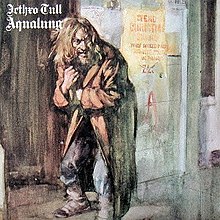Aqualung (Jethro Tull album)
| Aqualung | ||||
|---|---|---|---|---|

Cover art by Burton Silverman
|
||||
| Studio album by Jethro Tull | ||||
| Released | 19 March 1971 | |||
| Recorded | December 1970 – February 1971 | |||
| Studio | Island Studios, Basing Street, London | |||
| Genre | Progressive rock, folk rock, hard rock | |||
| Length | 42:55 | |||
| Label |
Chrysalis/Island (Europe) Reprise (America, Japan and Oceania) |
|||
| Producer | Ian Anderson, Terry Ellis | |||
| Jethro Tull chronology | ||||
|
||||
| Singles from Aqualung | ||||
|
||||
| Professional ratings | |
|---|---|
| Review scores | |
| Source | Rating |
| AllMusic |
|
| Christgau's Record Guide | C+ |
| MusicHound Rock | 4/5 |
| PopMatters | |
| Record Collector | |
| The Rolling Stone Album Guide | |
| Zagat Survey Music Guide - 1,000 Top Albums of All Time |
|
Aqualung is the fourth studio album by the rock band Jethro Tull. Released in 1971, Aqualung, despite the band's disagreement, is regarded as a concept album featuring a central theme of "the distinction between religion and God". The album's "dour musings on faith and religion" have marked it as "one of the most cerebral albums ever to reach millions of rock listeners".Aqualung's success signalled a turning point in the band's career, who went on to become a major radio and touring act.
Recorded at Island Records' studio in London, it was their first album with John Evan as a full-time member, their first with new bassist Jeffrey Hammond and last album featuring Clive Bunker on drums. Something of a departure from the band's previous work, the album features more acoustic material than previous releases; and—inspired by photographs of homeless people on the Thames Embankment taken by singer Ian Anderson's wife Jennie—contains a number of recurring themes, addressing religion along with Anderson's own personal experiences.
Aqualung has sold more than seven million units worldwide according to Anderson, and is thus Jethro Tull's best selling album. The album was generally well-received critically, and has been included on several music magazine "best of" lists. The album spawned two singles, "Hymn 43" and "Locomotive Breath".
After an American tour in 1970, bass player Glenn Cornick was fired from the band, and was replaced with Jeffrey Hammond, an old friend of Ian Anderson's.Aqualung would be the first recording Hammond would do with the band. It would also mark the first time John Evan had recorded a full album with the band, as his only prior involvement was to provide several keyboard parts on the previous 1970 album, Benefit. The album was one of the first to be recorded at the newly opened studios of Island Records in Basing Street, London. Led Zeppelin were recording their untitled fourth album at the same time. In an interview on the 25th anniversary edition of the album, Tull's bandleader Ian Anderson said that trying to record in that studio was very difficult, because of its "horrible, cold, echoey" feel. There were two recording studios at the location; Led Zeppelin worked in the smaller studio while Tull got the larger, which was the main body of a converted church. The orchestrals were arranged by David Palmer, who had worked with the band since 1968's This Was, and would later join as a keyboard player. Aqualung would be the last Jethro Tull album to include Clive Bunker as a band member, as he retired shortly after recording to start a family.
...
Wikipedia
